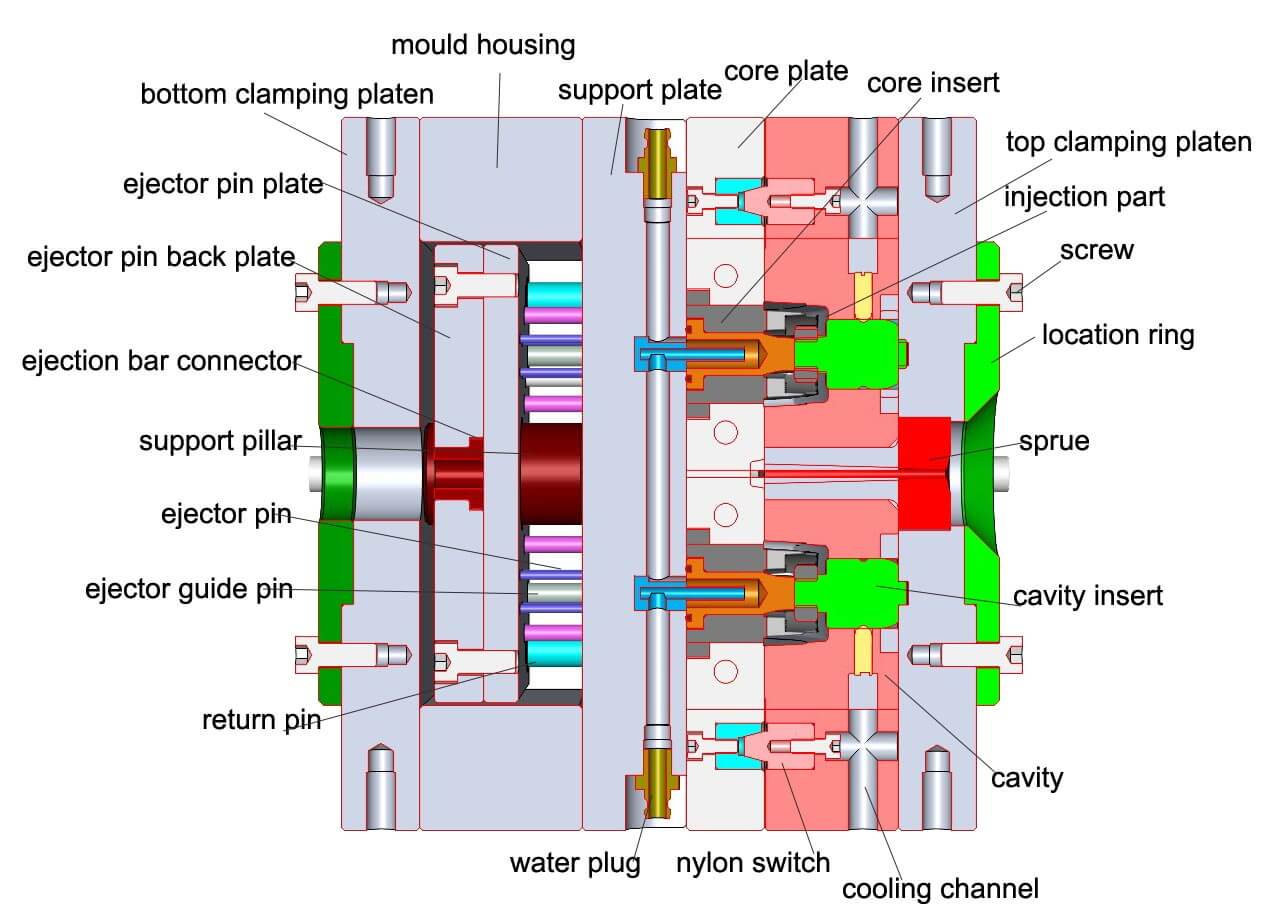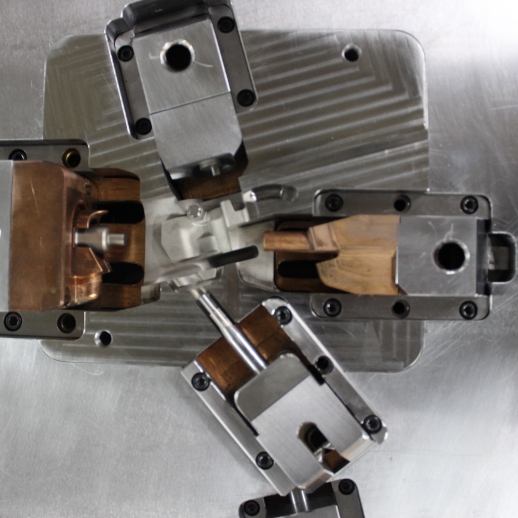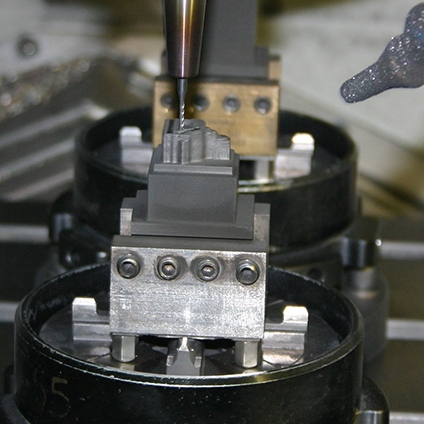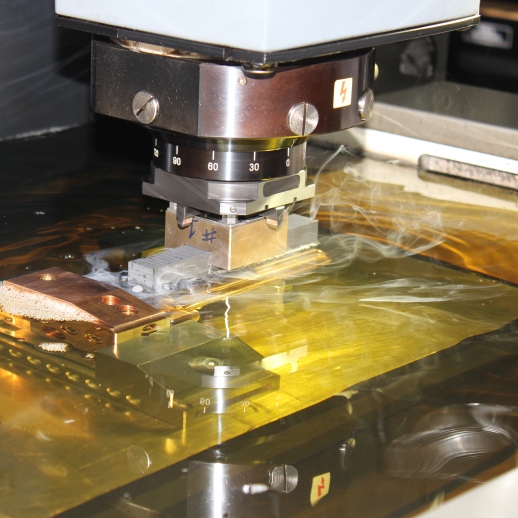Molding Terminology
A
AGING − Change of a material over time, which may lead to improvement or deterioration.
ALLOY − Composite material produced by blending polymers or copolymers with other polymers or elastomers.
ANNEAL − To heat a molded plastic piece and slowly then cool it to relieve stresses.
ANTISTATIC − Agents that are added to a molding material to make it less conducting.
A-SIDE − The mold half that mounts to the fixed side of the injection molding press. Resin is injected into the part cavity via the sprue through the A-side, which is also called cavity side of the mold.
AUTOMATIC MOLD − A mold that goes through the entire molding cycle without human help.

B
BACKING PLATE − In mold construction, a plate used as a support for the cavity blocks, guide pins and bushings. BARREL – Section of the molding press where resin is melted.
BLISTER − A raised defect on the surface of a molded part caused by trapped gases.
BLOW MOLDING − A method used to make hollow parts by using internal air pressure to force materials into the shape of the mold cavity.
BLUSH – A cylindrical protrusion within a part, often designed to accept fasteners.
BOSS − Projection on a plastic part designed to add strength, aid in alignment during assembly or to provide for fastenings.
BREATHING − The opening and closing of a mold to allow gases to escape early in the molding cycle.
B-SIDE − The mold half that mounts to the moving side of the injection molding press. The B-side has ejector pins to push the part out of the open mold.
BUBBLE – Like a blister, an internal void of trapped air or other gas within a plastic piece.
BUBBLER − A device that allows water to flow deep inside a mold cavity for cooling purposes.
BURNED – Signs of thermal damage on the surface of a plastic.
C
CAVITY − Depression in mold, which usually forms the outer surface of the molded part.
CENTER GATED MOLD − An injection or transfer mold wherein the cavity is filled with molding material through a sprue or gate directly into the center of the part.
CHALKING – Dry, chalk-like appearance on the surface of a plastic.
CHAMFER − Also known as a bevel, it is a flat truncated corner.
CHROMIUM PLATING − An process that deposits a hard film of chromium onto working surfaces of other metals. This provides resistance to corrosion, abrasion or erosion.
CLAMPING PLATE − A plate fitted to a mold and used to fasten mold to a molding machine.
CLAMPING FORCE − The pressure applied to a mold to keep it closed.
COLD SLUG − The first material to enter an injection mold. It gets its name because as it passes through the sprue opening, it is cooled below the effective molding temperature.
COLD SLUG WELL − Space provided opposite the sprue opening to trap the cold slug.
COMPRESSION MOLD − A mold that is open when the material is introduced. It shapes the material by heat and the pressure of closing.
COMPRESSION MOLDING − A molding technique in which a generally preheated molding material compound is placed in a heated open mold cavity. The mold is closed under pressure, causing the material to flow and fill the cavity. Pressure is maintained until the material has cured.
COMPRESSION RATIO − In an extruder screw, the ratio of volume available in the first flight at the hopper to the last flight at the end of the screw.
COMPRESSIVE STRENGTH − Crushing load at the failure of a specimen divided by the original sectional area of the specimen.
COOLING CHANNELS − Passageways in the body of a mold used to circulate a cooling medium to control temperature on the mold surface.
COOLING FIXTURE − Block of metal or wood holding the shape of a molded piece which is used to maintain the proper shape or dimensional accuracy of a molding after it is removed from the mold until it is cool enough to retain its shape without further appreciable distortion. Also called: “Shrink Fixture”.
CORE − A convex feature on either side of the mold that will enter an opposing cavity when the mold is closed.
CORE-CAVITY − The design of a mold where the A-side forms the outside of the part and the B-side forms the inside.
CORE PIN − Pin used to mold a hole.
CORING – Removing excess material from the cross section of a molded part. This helps achieved a uniform wall thickness.
CRAZING − Fine cracks that may form in a plastic material.
CREEP − The dimensional change with time of a material under load, following the initial instantaneous elastic deformation.
CRYSTALLINITY − A state of molecular structure in some resins that denotes uniformity and compactness of the molecular chains forming the polymer, attributed to the formation of solid crystals having a definite geometric form.
CURE − To harden a material by chemical reaction. This may be achieved with heat, chemical additives, or ultraviolet radiation.
CYCLE TIME − The complete sequence of actions in a process, from start to finish, where upon the cycle repeats.
D
DAYLIGHT OPENING − Clearance between two platens of a press in the open position.
DEFLASHING − Finishing techniques used to remove excess, which is called ‘flash’.
DEGRADATION – Decaying a plastic, also known as ‘deterioration’.
DELAMINTATION − The splitting of a plastic material along the plane of its layers.
DENSITY − Weight per unit volume of a substance.
DESSICANT − Substance that causes or sustains dryness.
DESTATICIZATION − Treating materials to reduce static electricity.
DETERIORATION – Impairment of the physical properties of a plastic.
DIELECTRIC − Insulating material.
DIMENSIONAL STABILITY − Ability of a plastic part to retain the precise shape in which it was molded, fabricated, or cast.
DISCOLORATION − Any change from the original color, often caused by overheating, light exposure, irradiation or chemical attack.
DISHED – Displaying a concave (dished-shaped) distortion.
DISPERSION − Finely divided particles of a material in suspension in another substance.
DOMED − Showing a convex (dome-shaped) distortion.
DOWEL − Pin used to maintain alignment between two or more parts of a mold.
DRAFT − The taper of features in the direction of pull. It allows deeper features to be produced in three-axis milling machines.
DRY COLORING − Method commonly used by fabricators for coloring plastic by tumble blending uncolored particles of the plastic material with dyes and pigments.
DRYING OF PLASTICS − Many plastics absorb water and must be dried prior to injection molding to ensure good cosmetics and material characteristics.
DUROMETER − A measure of the hardness of a resin. The higher the number on the scale, the harder the material.
DWELL − A pause in the application of pressure to a mold to let gas escape from the molding material.
E
EDGE GATE – An opening on the parting line of the mold to allow resin to enter the cavity.
EDM (Electric Discharge Machining) −A mold-making method that can create taller, thinner ribs than milling, text on top of ribs and square outside edges on parts.
EJECTOR PIN − A rod or pin that pushes a molding out of the cavity of a mold. Sometimes called an “ejector sleeve”.
ELASTICITY − The tendency of a material to return to its original shape after being deformed.
ELASTOMER − A material that has the elastic properties of natural rubber.
ELECTRIC DISCHARGE MACHINING (EDM) − A metal working process applicable to mold construction in which controlled sparking is used to erode away the work piece.
ELECTRONIC TREATING − A method of oxidizing a film of polyethylene to render it printable by passing the film between electrodes and subjecting it to a high voltage corona discharge.
ELECTROPLATING − Deposition of metals on certain plastics and molds for finish.
ELONGATION − The fractional increase in length of a material stressed in tension.
EMBOSSING − Techniques used to create depressions of a specific pattern in plastics film and sheeting. Such embossing in the form of surface patterns on molded part by the treatment of the mold surface by photoengraving or other process.
ENVIRONMENTAL STRESS CRACKING (ESC) − The tendency of a plastic piece to crack due to chemicals, weather, or stress.
EXTRUSION − The compacting of a plastic material and the forcing of it through an orifice in more or less continuous fashion.
F
FABRICATE − To work a material into a finished form by machining, forming, or other operation.
FAMILY MOLD − A mold with several cavities, each of which forms a part of a finished product.
FAN GATE − A shallow gate somewhat wider than the runner from which it extends.
FIBER – Small pieces of a materials used to reinforce plastics.
FILLER – Additive to improve the hardness or the cost a resin.
FILLET − A rounded filling of the internal angle between two surfaces.
FINISH − To complete the secondary work on a molded part so it is ready for use.
FIXTURE − Means of holding a part during a machining or other operation.
FLASH − Extra plastic attached to a molding along the parting line; under most conditions it would be objectionable and must be removed before the parts are acceptable.
FLASH GATE − Usually a long gate extending from a runner which runs parallel to an edge of a molded part along the flash or parting line of the mold.
FLEXURAL STRENGTH − Ability of a material to flex without breaking or permanent distortion.
FLOW − The fluidity of a plastic material during molding.
FLOW LINE − A mark on a molded piece made by the meeting of two flow fronts during molding.
FLOW MARKS − Wavy surface appearance on a molded object caused by improper flow of the material into the mold. See SPLAY MARKS.
G
GATE − The location where the plastic enters the part.
GF − Stands for “glass filled,” it refers to a resin with glass fibers mixed into it. Glass filled resins are much stronger and more rigid than the corresponding unfilled resin, but also more brittle. Resins can also be filled with carbon fiber, stainless steel, etc. In general, filled resins can be very susceptible to warp.
GLOSS − The shine or luster of the surface of a material.
GUIDE PINS − Devices that maintain proper alignment of core and cavity as mold closes.
H
HARDNESS − The resistance of a material to compression and indentation.
HAZE − Cloudiness in a plastic material.
HOT TIP GATE − An injection molding method that uses a heated gate on the A-side of the part to eliminate the creation of any runner or sprue.
HOT-STAMPING − Engraving operation for marking plastics in which roll leaf is stamped with heated metal dies onto the face of the plastics.
HYGROSCOPIC − Tending to absorb moisture.
I
IMPACT STRENGTH − The ability of a material to withstand shock loading.
INJECTION MOLDING − A process for manufacturing parts by injecting a heat-softened plastic material into a cavity that shapes the material.
INJECTION BLOW MOLDING − A blow molding process in which the parison to be blown is formed by injection molding.
J
JETTING − Marks caused by the resin entering a mold at high speed. occurring near a gate.
K
KIRKSITE − An alloy of aluminum and zinc used for the construction of blow molds; it imparts a high degree of heat conductivity to the mold.
KNIT LINES − A mark on a molded piece made by the meeting of two flow fronts during molding. Also called “Weld Line” or “Flow Line”.
L
LAMINAR FLOW − Laminar flow of thermoplastic resins in a mold is accompanied by solidification of the layer in contact with the mold surface that acts as an insulating tube through which material flows to fill the remainder of the cavity. This type of flow is essential to duplication of the mold surface.
LIGHT-RESISTANCE − The ability to resist fading after exposure to light.
LIVING HINGE − A thin section of plastic used to connect two parts and keep them together while allowing them to open and close.
M
MATTE FINISH − A type of dull, non-reflective finish.
MEDICAL GRADE – A resin used to make medical equipment or supplies.
METAL SAFE − A change to the part design that requires the removal of metal from the mold to produce the desired geometry, which means that a part design change can take place without entirely re-machining the mold.
MELT STRENGTH − The strength of the plastic while in a molten state.
MODULUS OF ELASTICITY − The ratio of stress to strain in a material that is elastically deformed.
MOLDING MATERIAL − Plastic material such as resin, filler, pigments, plasticizers and other ingredients for use in the molding process.
MOLDING PRESSURE − Pressure applied to compound that allows the complete transformation to a solid dense part.
MOLDING SHRINKAGE – The difference in dimensions, expressed in inches per inch, between a molding and the mold cavity in which it was molded, both the mold and the molding being at normal room temperature when measured. Also called “Mold Shrinkage,” or “Shrinkage,” and “Contraction.”
MOLD RELEASE − A lubricant applied to a mold cavity that keeps the molded piece from sticking to it.
MOVABLE PLATEN − The moving platen of an injection or compression molding machine to which half of the mold is secured during operation.
MULTI-CAVITY MOLD − A mold with two or more cavities of the same part, used to reduce costs by allowing for higher volume production.
N
NOTCH SENSITIVITY − The sensitivity of a material to fracture due to the presence of a notch, crack, or scratch. Brittle materials have high notch sensitivity.
NOZZLE − The fitting on the end of the barrel of an injection molding press where the resin enters the sprue.
O
OUT-OF-ROUND – Unbalanced circular form.
P
PARTING LINE – Place where the halves of a mold meet when closed.
PERMANENT SET – The increase in length of a material after being stretched.
PINPOINT GATE − A restricted opening through which molten resin flows into a mold cavity.
PITCH – The distance from any point on the flight of a screw line to the corresponding point on an adjacent flight.
PLASTIC − Natural and synthetic material and chemicals that can be transformed into a solid, as either or both heat and pressure is applied.
PLASTICITY – The quality of material that allows it to be formed into different shapes.
PLASTICIZE − To soften a material and make it moldable.
PLASTICIZER − A material that, when added to a plastic, increases its workability.
POLYMER − Any of numerous natural and synthetic compounds of usually high molecular weight consisting of up to millions of repeated linked units, each a relatively light and simple molecule.
PERFORM − A pill, tablet, or biscuit used in thermoset molding.
PREHEATING – The heating of a compound before molding.
PREMIX − A molding compound prepared before molding operations that contains the resin, fillers, catalysts and other compounds needed for the molding process.
PRESSURE FORMING − A thermoforming process that uses pressure to push the sheet to be formed against the mold surface.
PROTOTYPE MOLD − A simplified mold made from a lighter material as a test before the final mold is made.
R
RECIPROCATING SCREW − A combination injection and plasticizing unit in which an extrusion device with a reciprocating screw is used to plasticize the material.
REINFORCED MOLDING COMPOUND − A material reinforced with special fillers.
REINFORCEMENT − A material added to a plastic to increase its strength.
RESIN − Solid or semi-solid organic products used to form a plastic part.
RETAINER PLATE − The plate on which demountable pieces, such as mold cavities, ejector pins, guide pins, and bushings are mounted during molding: usually drilled for water lines.
RIB − A reinforcing member of a fabricated or molded part.
ROCKWELL HARDNESS − A common method of testing a material’s hardness by piercing a test piece with a diamond or steel ball.
RUBBER − An elastomer capable of elastic recovery after being stretched.
RUNNER − The channel in a mold that connects the sprue with the gate to the cavity.
RUNNER SYSTEM – The sprues, runners and gates that lead material from the nozzle of an injection machine to the mold cavity.
S
SCREW PLASTICATING INJECTION MOLDING − A technique in which the plastic is converted from pellets to viscose melt by an extruder screw that is part of the molding machine.
SELF-EXTINGUISHING − The tendency of a flammable material to stop burning when heat is removed.
SEMI-AUTOMATIC MOLDING MACHINE − A molding machine in which only part of the operation is controlled by the direct action of a human.
SHELF LIFE − An expression to describe the time a molding compound can be stored without losing its molding properties.
SHORT SHOT − A molded part produced when the mold has not been filled completely.
SHOT – Volume of material needed to fill the cavity.
SHOT CAPACITY − The maximum weight of material which a machine can produce from one forward motion of the plunger or screw.
SIDE CORING OR SIDE DRAW PINS − Projections used to core a hole in a direction other than the line of closing of a mold, and which must be withdrawn before the part is ejected from the mold.
SILICONE − Chemical derived from silica used in molding as a release agent and lubricant.
SINK MARK − A depression or dimple on the surface of an injection molded part.
SOLVENT − A substance – usually liquid – that dissolves other substances.
SPECIFIC GRAVITY − The density of any material divided by that of water.
SPIN WELDING − A process of fusing two objects together by forcing them together while one of the pair is spinning, until frictional heat melts the interface. Spinning is then stopped and pressure held until they are frozen together.
SPLAY MARKS − Lines found in part after molding, usually due to flow of material in mold.
SPRUE – Channel through which liquid enters the mold.
SPRUE-BUSHING − A hardened steel insert in an injection mold which contains the tapered sprue hold and has a suitable seat for the nozzle of the injection cylinder.
SPRUE GATE – Location at which molten resin flows into the mold cavity.
STABILIZER − An ingredient used in the formulation of some plastics to assist in maintaining the physical and chemical properties of the compounded materials at their initial values throughout the processing and service life of the material.
STATIONARY PLATEN − The plate of an injection or compression molding machine to which the front plate of the mold is secured during operation.
STRIPPER-PLATE − A plate that strips a molded piece from core pins or core, the stripper-plate is set into operation by the opening of the mold.
SUBMARINE GATE − A type of gate where the opening from the runner into the mold is located below the parting line or mold surface.
SURFACE FINISH – The finish of a molded product.
SURFACE TREATING − Any method of treating a material to make the surface receptive to inks, paints, lacquers, and adhesives.
T
TAPPING − Cutting threads in the walls of a circular hole.
TENSILE STRENGTH − The force required to pull a material to the point where it breaks.
THERMAL CONDUCTIVITY − Ability of a material to conduct heat; physical constant for quantity of heat that passes through unit cube of a substance in unit of time when difference in temperature of two faces is 1°.
THERMAL STRESS CRACKING (TSC) − Cracking of some thermoplastic resins due to high temperatures.
THERMOPLASTIC − A material that will soften when heated and harden when cooled.
THERMOSET − A material that will undergo or has undergone a chemical reaction by the action of heat and pressure, catalysts, ultra-violet light, etc., leading to a relatively infusible state. Typical of the plastics in the thermosetting family are the aminos (melamine and urea), most polyesters, alkyds, epoxies, and phenolics.
THREAD PLUG OR RING OR CORE − A part of a mold that shapes a thread and must be unscrewed from the finished piece.
TIE BARS − Bars that provide structural rigidity to the clamping mechanism of a press, often used to guide platen movement.
TOLERANCE − A specified allowance for deviations in weighing, measuring. etc., or for deviations from the standard dimensions or weight.
U
ULTRASONIC SEALING OR BONDING − A sealing method in which sealing is accomplished through the application of vibratory mechanical pressure at ultrasonic frequencies (20 to 40 kc.). Electrical energy is converted to ultrasonic vibrations using either a magneto strictive or piezoelectric transducer. The vibratory pressures at the interface in the sealing area develop localized heat losses which melt the plastic surfaces effecting the seal.
ULTRASONIC INSERTION − The inserting of a metal insert into a thermoplastic part by the application of vibratory mechanical pressure at ultrasonic frequencies.
UNDERCUT − (a.) Having a protrusion or indentation that impedes withdrawal from a two-piece, rigid mold. Flexible materials can be ejected intact even with slight undercuts. (n.) Any such protrusion or indentation; depends also on design of mold.
UNIT MOLD − Mold designed for quick changing interchangeable cavity parts.
V
VACUUM METALIZING − Process in which surfaces are thinly coated with metal by exposing them to the vapor of metal that has been evaporated under vacuum (one millionth of normal atmospheric pressure.)
VENT − In a mold, a shallow channel or minute hole cut in the cavity to allow air to escape as the material enters.
VOID − A bubble in the center of a thermoplastic part, usually caused by excessive shrinkage.
W
WARPAGE − Dimensional distortion in a plastic object after molding.
WATER ABSORPTION − The ability of a thermoplastic material to absorb water.
Y
YIELD VALUE − The lowest stress at which a material undergoes plastic deformation.
Lorem ipsum dolor sit amet, consectetur adipiscing elit. Ut elit tellus, luctus nec ullamcorper mattis, pulvinar dapibus leo.



